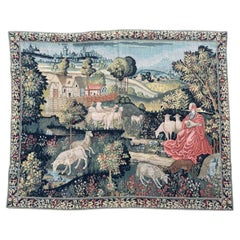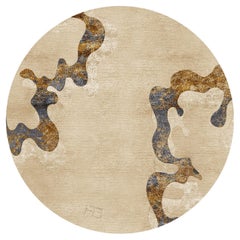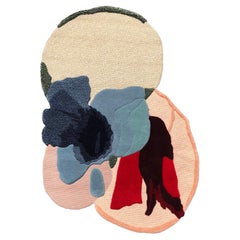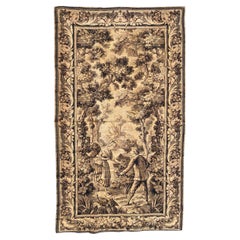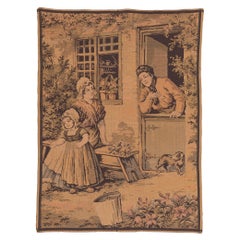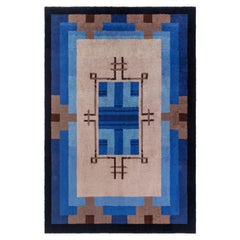Western European Rugs
to
1,386
Width
to
Length
to
4,050
3,810
102
2,292
491
428
153
117
40
34
33
30
22
11
11
9
9
8
7
7
3
410
672
2,728
4,152
728
1,314
547
91
49
146
98
75
133
177
164
70
101
7,416
6,428
1,291
971
199
3,623
3,616
7,962
5,147
5,977
4,828
2,893
2,145
1,774
1,356
574
311
122
103
76
Western European Rugs For Sale
Wonderful Vintage French Aubusson style Hand Printed Tapestry “ country concert”
Located in Saint Ouen, FR
Concert Champêtre ( country concert )
Very beautiful mid century French Aubusson style tapestry with a beautiful 15th century tapestries design showing a scene in the countryside, ou...
Category
Mid-20th Century French Aubusson Western European Rugs
Materials
Wool, Cotton
$2,357 Sale Price
20% Off
Circular Metamorphosis Wool and Art Silk Rug FB Collection
Located in Milan, IT
A wavy and earth-toned pattern in opposite sections of this wool and artificial silk rug add a touch of color and elegance. A designer logo and cotton backing complete this beige rug...
Category
2010s Italian Western European Rugs
Materials
Wool, Silk
Irregular Shape Contemporary Rug with Red, Pink, Blue 'Winter Rose' by Rag Home
By RAG home
Located in Jakarta Selatan, ID
A harmonious amalgamation of artistry and nature, 'Winter Rose' by RAG Home is an abstract rendition that unveils the essence of a single rose blossom in December. Delicate shades of...
Category
2010s Indonesian Modern Western European Rugs
Materials
Wool, Acrylic, Yarn
Bobyrug’s Pretty Antique French Jaquar Tapestry
Located in Saint Ouen, FR
Very beautiful late 19th century tapestry with beautiful design of a hunter at the town, and beautiful golden colors, mechanical Jaquar manufacturing woven with wool and cotton.
✨✨✨...
Category
Late 19th Century French Aubusson Antique Western European Rugs
Materials
Wool, Cotton
Antique French Tapestry with Dutch Pictorial Scene, 03'02 x 04'03
By Jean-Baptiste Oudry
Located in Dallas, TX
78542 Antique French Tapestry with Dutch Pictorial Scene, 03'02 x 04'03. This captivating handwoven wool antique French tapestry depicts a charming Dutch pictorial scene, evoking the...
Category
Early 20th Century French Aubusson Western European Rugs
Materials
Wool
$359 Sale Price
20% Off
Doris Leslie Blau Antique French Art Deco Rug
Located in New York, NY
Antique French Art Deco Rug
Size: 6'8" x 10'0" (203 × 304 cm)
A brilliant expression of the modernist ethos, this circa 1930 French Art Deco rug showcases the architectural elegance ...
Category
Mid-20th Century French Art Deco Western European Rugs
Materials
Wool
20th Century Yellow Pink Green Flowers Arraiolos Rug from Portugal, circa 1900s
Located in Firenze, IT
The making of carpets in Portugal dates back to the Renaissance period using the braid stitch, embroidered on large hemp tea towels with the needle. The Portuguese carpet is called A...
Category
Early 20th Century Portuguese Western European Rugs
Materials
Wool
1900 Antique French Tapestry Wool & Silk Game 7x7 Square 196cm x 201cm
Located in New York, NY
1900 Antique French Tapestry Wool & Silk Game 7x7 Square 6'5" x 6'7" 196cm x 201cm
"This is an outstanding antique French Aubusson tapestry in a fantastic large square size- This wo...
Category
Early 1900s French Baroque Antique Western European Rugs
Materials
Wool, Silk
Rare Danish Ege Axminster rug - Vincent van Gogh "Olive Trees" in wool
Located in Firenze, FI
Danish carpet made by Ege Axminster A/S - Denmark for the 20th century masters carpet collection. label on back Licensed by: Van Gogh International B.V. in 1995 Design No. 80583 rug ...
Category
1990s Danish Western European Rugs
Materials
Wool
cc-tapis Memoriae Tempore Collection by Duccio Maria Gambi
Located in Brooklyn, NY
Tempore, Latin term denoting a temporary or provisional period. The starting point for the creative process of a collection of hand-knotted rugs made of Himalayan wool evoking a temp...
Category
21st Century and Contemporary Nepalese Modern Western European Rugs
Materials
Wool
Antique French Charles X Savonnerie Rug. 10 ft 5 in x 14 ft 1 in
Located in New York, NY
Beautiful Antique French Charles X Savonnerie Rug , Country of Origin / Rug Type: French Rug, Circa Date: 1820. Size: 10 ft 5 in x 14 ft 1 in (3.17m x 4.29 m).
Category
Early 19th Century French Charles X Antique Western European Rugs
Materials
Wool
Very beautiful vintage French Cogolin rug Aubusson design
Located in Saint Ouen, FR
Nice mid century French Aubusson style Cogolin rug with beautiful floral design and nice colours , entirely hand knotted with wool on cotton foundation
✨✨✨
"Experience the epitome ...
Category
Mid-20th Century French Aubusson Western European Rugs
Materials
Wool, Cotton
$1,744 Sale Price
20% Off
Rug in style Napoleon III French Aubusson Manufactury, 2m70x3m70- N° 1527
Located in Paris, FR
Rug in Napoleon III style, Aubusson factory - 2m70x3m70 - No. 1527
Period: 20th century
Style: Napoleon III
Condition: Perfect condition
Material: Wool
Length: 270 cm
Width: 370 cm
D...
Category
1980s Vintage Western European Rugs
Materials
Wool
Vintage French Aubusson Wool Rug - Tropical Fruit & Flowers with Monkeys
Located in Decatur, GA
Vintage French Aubusson flat weave wool rug with a tropical fruit and flowers motif with monkeys!
No stains, holes, tears, etc. Slightly off plumb. Ready for use.
103" x 68"
**FRE...
Category
Mid-20th Century French Aubusson Western European Rugs
Materials
Wool
Zabihi Collection 19th Century Ivory Antique French Aubusson Pillow
Located in New York, NY
Authentic stand-alone pillow made from a 19th century French Aubusson rug
Measures: 18" x 18",
Category
Early 19th Century French Aubusson Antique Western European Rugs
Materials
Wool, Cotton, Foam
Bubbles Colourful Modern Irregular Circle Rug Large Size
By Sonya Winner
Located in London, GB
Bubbles is a multicoloured area rug entirely handmade in pure wool by artisan weavers, playfully using colour as if it is made of translucent paper. This natural wool area rug is a p...
Category
2010s British Modern Western European Rugs
Materials
Wool
Jaime Hayon 'Troupe' Rug for Nanimarquina
Located in Tilburg, NL
Jaime Hayon 'Troupe' Rug for Nanimarquina. New, current production. 170 x 240cm.
Crazy, dreamlike and with a sense of humor, resembling a party: such is Jaime Hayon's new collecti...
Category
21st Century and Contemporary Spanish Mid-Century Modern Western European Rugs
Materials
Wool
Zabihi Collection late 19th Century Green Sultanabad Rug
Located in New York, NY
A phenomenal Persian Mahal/Sultanabad Carpet woven by the Swiss firm, Ziegler & Co. What makes this rug outstanding is that its Predominantly green,
8'2'' x 10'
In the late 1800s...
Category
Late 19th Century Persian Sultanabad Antique Western European Rugs
Materials
Wool
Mid-Century Modern Rug Finlandia with Nordic Traditional Symbols, Germany 1970s
Located in Beograd, RS
In this listing you will find a round Mid-Century Modern area rug, featuring traditional Nordic symbols. The rug was manufactured by Teppich Siegel, large German rug...
Category
1970s German Mid-Century Modern Vintage Western European Rugs
Materials
Polyester
Tappeto Iconico Design Italiano Contemporaneo Blu by Deanna Comellini 200x300 cm
Located in Bologna, IT
"Kama" è un tappeto rivoluzionato entrato nella storia del design firmato Deanna Comellini, fondatrice e Art Director dell'azienda pioniere del tappeto contemporaneo G.T.DESIGN.
"Ka...
Category
2010s Indian Modern Western European Rugs
Materials
Other
Late 19th Century French Figurative Tapestry
Located in New York, NY
Late 19th century French Tapestry
Measures: 7'10" x 8'6".
Category
Late 19th Century French Vienna Secession Antique Western European Rugs
Materials
Wool
cc-tapis Bliss Ultimate Rug by Mae Engelgeer
Located in Brooklyn, NY
Hand knotted in the cc-tapis atelier in Kathmandu, Nepal. The rug is made with a cotton weave, Himalayan wool and silk pile coming from the areas surrounding the atelier. 125.000 ind...
Category
21st Century and Contemporary Nepalese Modern Western European Rugs
Materials
Cotton
$12,464 / item
Pretty Vintage Aubusson Style médiéval design Jacquard Tapestry « deer chase »
Located in Saint Ouen, FR
very beautiful Aubusson style tapestry, with a design of a medieval tapestry representing « deer chase» (poursuite du cerf), with Beautiful colours with green background, pink, yell...
Category
Mid-20th Century French Aubusson Western European Rugs
Materials
Wool, Cotton
$1,697 Sale Price
20% Off
Pretty antique tapestry cardboard hand painted panel
Located in Saint Ouen, FR
Pretty 19th century French tapestry cardboard with a nice design of swing game featuring a young man standing pushing a young girl sitting on the swing. At a setting in the woods, be...
Category
Late 19th Century French Romantic Antique Western European Rugs
Materials
Cotton, Linen
$2,456 Sale Price
20% Off
Mid-19th Century French Aubusson Manufactory Rug - Dim: 3m35x2m55 - N° 1532
Located in Paris, FR
Artist: Aubusson Manufactory, 19th Century
Era: 19th Century
Condition: Perfect
Material: Wool
Length: 255 cm
Width: 335 cm
Depth: 1 cm (with doubler)
This magnificent rug, having b...
Category
Mid-19th Century French French Provincial Antique Western European Rugs
Materials
Wool, Silk
Vintage Robert Debiève Floral and Pictorial Tapestry “La Forêt” Rug & Kilim
Located in Long Island City, NY
This 3x5 vintage Aubusson tapestry is a rare and special new curation from Rug & Kilim—a signed mid-century original by French artist Robert Debiève, entitled “La Forêt”, handwoven i...
Category
1950s French Aubusson Vintage Western European Rugs
Materials
Wool
Nice Vintage Aubusson Style Jaquar Tapestry
Located in Saint Ouen, FR
Beautiful Aubusson style tapestry with nice design with a gallant scene and nice colors, mechanical Jaquar manufacturing with wool and cotton.
Size: 100 x 140 cm.
Category
Mid-20th Century French Aubusson Western European Rugs
Materials
Wool
Early 20th Century German Tetex Rug
Located in Chicago, IL
A rare and wonderful early 20th century German Tetex rug woven with a traditional Persian Heriz pattern including a large central floral medallion living amidst a field of more styli...
Category
1930s German Heriz Serapi Vintage Western European Rugs
Materials
Wool
Rare Viennese Rug Doris Leslie Blau
Located in New York, NY
Rare Viennese Rug Doris Leslie Blau
Size: 12'8" × 15'10" (386 × 482 cm)
Circa: 1900
Age: Vintage
Color: Beige, Green
Type: Viennese
Style: Art Deco
Origin: Europe
This vintage Vienne...
Category
Early 20th Century Austrian Vienna Secession Western European Rugs
Materials
Wool
Antique Donegel Voysey Rug in Red with Colorful Floral Pattern - Rug & Kilim
Located in Long Island City, NY
Made with hand-knotted wool and originating from Ireland circa 1910-1920, this antique Donegel Voysey rug is a 13x14 collectible from the revered arts and crafts movement
On the Des...
Category
1910s Irish Arts and Crafts Vintage Western European Rugs
Materials
Wool
Antique Donegal Irish Rug. 10 ft 2 in x 10 ft 4 in (3.1 m x 3.15 m)
Located in New York, NY
Beautiful square size antique Donegal Irish rug, country of origin: Ireland, circa 1920. Size: 10 ft 2 in x 10 ft 4 in (3.1 m x 3.15 m)
Delicate b...
Category
Early 19th Century Irish Arts and Crafts Antique Western European Rugs
Materials
Wool
Customizable ClassiCon Centimetre Rug in Hand Knotted Wool by Eileen Gray
By Eileen Gray
Located in New York, NY
Eileen Gray created not only some of the most important furniture classics of the 20th century but also had her own studio where rugs were produced according to her designs: masterpieces of abstract textile art made of 100% pure new wool, hand knotted and processed to the highest quality. Designed for the Salon of the Villa E1027, the Centimetre Rug...
Category
21st Century and Contemporary German Modern Western European Rugs
Materials
Wool
Pretty vintage French Aubusson style hand printed tapestry, medieval design
Located in Saint Ouen, FR
"Experience the timeless elegance of this exquisite French Aubusson style tapestry, capturing the essence of an 15th century tapestry with a design titled « bord de L’eau » (water's...
Category
Mid-20th Century French Aubusson Western European Rugs
Materials
Wool
$1,866 Sale Price
20% Off
Pretty vintage French Aubusson style Jacquard Tapestry « Hunting with hounds »
Located in Saint Ouen, FR
"Discover the timeless elegance of this exquisite vintage French tapestry featuring a hunting with hounds scene.
A noble pastime and a favorite pastime of the great men of the time,...
Category
Mid-20th Century French Aubusson Western European Rugs
Materials
Wool, Cotton, Acrylic
$1,367 Sale Price
20% Off
Ege Axminster Rug Abstract Smoke Denmark Mid Century Modern 4.5 x 6.5 Danish
Located in Lake Worth, FL
Crafted with precision, the Ege Axminster "Cross Over" Design Danish Modern Rug encapsulates the essence of mid-century modern abstract design. Orig...
Category
Late 20th Century Danish Mid-Century Modern Western European Rugs
Materials
Wool
Bobyrug’s Pretty Vintage French Jaquar Tapestry
Located in Saint Ouen, FR
Nice french Aubusson style tapestry with beautiful design of nature and town, and nice colors, woven by mechanical Jaquar manufacturing with wool and cotton.
✨✨✨
"Experience the epi...
Category
Mid-20th Century French Aubusson Western European Rugs
Materials
Wool, Cotton
$1,367 Sale Price
20% Off
Ethel Halvar-Andersson — Hand-Knotted Geometric Carpet, Sweden, 1940s
Located in Brussels, BE
Ethel Halvar-Andersson — Hand-Knotted Geometric Carpet, Sweden, 1940s
Signed “EHA”
Dimensions: approx. 242 x 178 cm (95.3 x 70.1 in)
Designer: Ethel Halvar-Andersson (1917–2011)
Ori...
Category
1940s Swedish Mid-Century Modern Vintage Western European Rugs
Materials
Wool
Rust Red Wavy Customizable Cowhide Russet Onda Area Rug Small
By Art Hide
Located in Charlotte, NC
Introducing the Onda Rug in Russet, a breathtaking masterpiece that will ignite your senses and elevate the very essence of your living space. With its rich, ...
Category
21st Century and Contemporary Pakistani Art Deco Western European Rugs
Materials
Cowhide
$3,650 Sale Price / item
15% Off
cc-tapis Rug Ultimate Bliss Gold Round by Mae Engelgeer for Duplex
Located in Brooklyn, NY
Duplex launches “Gold is Bold" project: a unique collaboration with cc-tapis to celebrate boldness.
The iconic Biss rug collection designed by Mae Engelgeer and hand knotted in N...
Category
21st Century and Contemporary Nepalese Modern Western European Rugs
Materials
Wool, Silk
Doris Leslie Blau Oversized 1920s English Axminster Carpet
Located in New York, NY
Oversized 1920s English Axminster Carpet with Herati-Inspired Floral Motifs in Rust and Sage
Size: 20'3" × 22'7" (617 × 688 cm)
This exquisite 1920s English Axminster rug showcases t...
Category
Early 20th Century English Western European Rugs
Materials
Wool
Mehraban Antique Square French Tapestry
Located in WEST HOLLYWOOD, CA
Our Los Angeles rug store is proud to have this beautiful antique French tapestry rug. This authentic vintage square piece depicts daily life in the F...
Category
1890s French Antique Western European Rugs
Materials
Tapestry, Wool
Bobyrug’s Pretty mid century Brutalist Macrame tapestry town design
Located in Saint Ouen, FR
Introducing a Modern Design meets Neo Classic with a touch of Bohemian flair! Elevate your space with our exquisite macramé hangings. Crafted from natural materials like cotton rope ...
Category
Mid-20th Century Spanish Modern Western European Rugs
Materials
Wool, Cotton
cc-tapis Super Fake Super Runner Rug by Bethan Laura Wood
Located in Brooklyn, NY
Hand knotted in the cc-tapis atelier in Kathmandu, Nepal. The rug is made with a cotton weave, Himalayan wool, pure silk and linen coming from the areas surrounding the atelier. 125....
Category
21st Century and Contemporary Nepalese Modern Western European Rugs
Materials
Cotton
Antique French Aubusson Rug
Located in New York, NY
Antique French Aubusson rug
France, circa 1870
Handwoven.
Category
Late 19th Century French Aubusson Antique Western European Rugs
Materials
Wool
$28,000
Pretty Mid Century French Aubusson style Jacquard Tapestry, « by Goya »
Located in Saint Ouen, FR
Very pretty mid century french Aubusson style tapestry with beautiful design from the painter « Francisco de Goya (1775-1792) for the royal manufactury of Tapestry »
Tapestry crafte...
Category
Mid-20th Century French Aubusson Western European Rugs
Materials
Wool, Cotton
Rya Blue and Green Shag Rug
By Ege Rya
Located in Philadelphia, PA
Rya Rug in Blue and Green. Vibrant Colors still look great! Rug does not show much wear at all! Back side shows some discoloration. Canvas bindings still in place at each end.
Category
1960s Danish Scandinavian Modern Vintage Western European Rugs
Materials
Wool
Antique French Aubusson Verdure Tapestry
Located in Dallas, TX
77764, antique French Verdure tapestry. This hand-woven antique French Aubusson verdure tapestry depicts a landscape scene of the French countryside. ...
Category
Early 20th Century French Medieval Western European Rugs
Materials
Wool
$7,199 Sale Price
20% Off
1970s design rug, Dal Lago manufactory, Venice
Located in Milano, Lombardia
Wool/acrylic blend rug with informal gray-based pattern with black, red, yellow and white. Typically 60s/70s, this item is a stock item, never used. We have had it cleaned and theref...
Category
1970s Italian Mid-Century Modern Vintage Western European Rugs
Materials
Wool, Acrylic
Pretty Vintage Aubusson Style medieval museum design Jacquard Tapestry
Located in Saint Ouen, FR
very beautiful Aubusson style tapestry, with a design of a medieval Rhenish tapestry (1480-1490) Basel (Switzerland), representing a royal court of France, the arms of France, with b...
Category
Mid-20th Century French Aubusson Western European Rugs
Materials
Wool, Cotton
$1,848 Sale Price
20% Off
Antique French Aubusson Pillow with Baroque Style, Tête de Femme Aphrodite
Located in Dallas, TX
78616 Antique French Aubusson Pillow, 01'06 x 01'00.
Reflecting elements of both Baroque and Renaissance, this handwoven antique French Aubusson pillow is a captivating vision of wov...
Category
Late 19th Century French Aubusson Antique Western European Rugs
Materials
Wool, Silk
$399 Sale Price
20% Off
cc-tapis Chateau Orlando Collection Jewelled Runner by Luke Edward Hall
Located in Brooklyn, NY
Pure wool jacquard rug with design inspired by 1920s illustrations of jewellery discovered by Luke in a museum's collection. "Our four Chateau Orlando rug designs for cc-tapis are no...
Category
21st Century and Contemporary Nepalese Western European Rugs
Materials
Wool
Antique Wool Handmade Floral Golden-Brown French Savonnerie Rug
Located in West Hollywood, CA
This antique, circa 1900, French Savonnerie rug has a golden-brown field with a central eau-de-nil roundel containing a shaded ivory and red interlocking acanthus leaf vine, an outer...
Category
Early 20th Century French Western European Rugs
Materials
Wool
Inspired Deco Modern Rug by Doris Leslie Blau
Located in New York, NY
Inspired Deco Modern Rug by Doris Leslie Blau
Size: 11'7" × 17'8" (353 × 538 cm)
A modern Art Deco inspired rug hand knotted out of wool. The design displays bold, geometric blocks o...
Category
21st Century and Contemporary European Art Deco Western European Rugs
Materials
Wool
Vintage Circular beige, brown and turquoise Wool Rya Rug
By Desso
Located in Vienna, AT
Large Circular Danish modern rya rug labeled Norsk for British carpet centre, Axminster, England. 100% wool.
Charming colours in creamy beige, blue and turquoise, very decorative...
Category
1970s Danish Mid-Century Modern Vintage Western European Rugs
Materials
Wool
Pretty Vintage Aubusson Style Jaquar Tapestry “fountain rest “
Located in Saint Ouen, FR
Very pretty mid century French tapestry with nice galant design titled “Repos Fontaine” (Fontain Rest) and beautiful colors, woven with mechanical Jaquar looms with wool, acrylic and...
Category
Late 20th Century French Aubusson Western European Rugs
Materials
Wool, Cotton
$1,188 Sale Price
20% Off
Nice antique distressed European rug oushak design
Located in Saint Ouen, FR
Beautiful early 20th century large European rug with a design of the antique Turkish oushak rugs and nice colours with a red background and green, purple, brown, yellow and white, en...
Category
Early 20th Century European Oushak Western European Rugs
Materials
Wool, Cotton
$2,130 Sale Price
20% Off
Vintage Old Bessarabian Kilim Rug, Moldovan Moldavian Romanian Bulgarian Carpet
Located in Tokyo, JP
This is a Vintage Old Bessarabian Kilim Rug from Moldova with a rare and beautiful color composition.
Today it is a landlocked country in Eastern Europe, bordering Romania and Ukrai...
Category
Late 20th Century Moldovan Kilim Western European Rugs
Materials
Wool, Natural Fiber
cc-tapis Dipped Angle Rug
By cc-tapis
Located in Brooklyn, NY
Hand knotted in the cc-tapis atelier in Kathmandu, Nepal. The rug is made with cotton weave, Himalayan wool, silk and aloe pile, coming from the areas surrounding the atelier. 125.00...
Category
21st Century and Contemporary Nepalese Modern Western European Rugs
Materials
Cotton
cc-tapis WHAT DO WE ALL NEED? handmade rug by India Mahdavi
Located in Brooklyn, NY
A collection of hand-knotted rugs which seamlessly merges the worlds of art and design, using graphic elements to create a visual language that is both cryptic and playful.
India Ma...
Category
21st Century and Contemporary Nepalese Western European Rugs
Materials
Wool
Doris Leslie Blau Antique French Aubusson Rug
Located in New York, NY
Antique French Aubusson Rug
Size: 13'5" × 14'8" (408 × 447 cm)
A triumph of French decorative arts, this magnificent 19th-century Aubusson rug from circa 1870 is a celebration of sym...
Category
Late 19th Century French Aubusson Antique Western European Rugs
Materials
Wool
Recently Viewed
View AllMore Ways To Browse
Bullet Vase
Buncheong Ceramics
Burl Art Deco Cabinet Dry Bar
Camphor Wood Box
Capodimonte Cherub
Carved Wood Deer
Castaing Madeleine
Castelli Platone
Cathedral Clock
Cenedese Aquarium
Ceramic Dogs Italy
Ceramic Elephants 1970s
Chelsea Pottery
Chi Rho
Chinese Han Dynasty Bronze Vase
Chinese Screen Inlay
Chinese Stacking Box
Chinese Wash Stand
